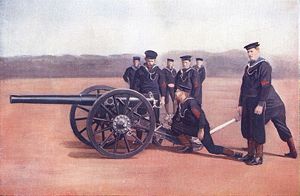QF 12-pounder 8-cwt Mk I naval gun
| Ordnance QF 12 pounder 8 cwt | |
|---|---|

Royal Navy gun and crew, late 1890s
|
|
| Type | Light field gun |
| Place of origin | United Kingdom |
| Service history | |
| Used by | British Empire |
| Wars |
Second Boer War World War I |
| Production history | |
| Designed | circa. 1894 |
| Specifications | |
| Barrel length | 84 inch bore (28 calibres) |
|
|
|
| Shell | Separate QF, 12.5 pounds (5.67 kg) Shrapnel, Common Lyddite |
| Calibre | 3-inch (76.2 mm) |
| Carriage | Wheeled, box trail |
| Muzzle velocity | 1,585 feet per second (483 m/s) |
| Maximum firing range | 5,100 yards (4,660 m) |
The Ordnance QF 12 pounder 8 cwt was a Royal Navy "landing gun" intended for navy use ashore. "8 cwt" refers to the weight of the gun and breech, approximately 8 cwt = 8 x 112 lb (51 kg) = 896 lb. This was how the British often differentiated between guns of the same calibre or weight of shell. This gun had a short barrel and was of relatively low power compared to the 12 pounders of 12 and 18 cwt, although it fired the same shells.
Fourteen were converted into anti-aircraft guns as Mk I*.
The Royal Navy eventually replaced the gun with the 3.7 inch Mountain Howitzer.
The gun was used in the early stages of the Second Boer War in Natal.
These guns were employed on land in the West Africa campaign. They were also employed in the East Africa campaign ("Logan's Battery" 6th Field Battery, 2 guns, towed first by Hupmobile cars and then REO lorries).
This gun was briefly used in the Battle of Gallipoli, as the Royal Navy had supplies of ammunition for it when the army was short of ammunition for its own guns. Several guns were landed in July 1915 and operated from frontline trenches.
There is a surviving example held and maintained at Devonport Field Gun Association Heritage Centre & Museum at Crownhill Fort, Plymouth. There are also three examples at the Royal Canadian Sea Cadets summer training camp at HMCS Acadia in Cornwallis, Nova Scotia. They still fired regularly, although they only fire blanks for ceremonial and training purposes.
This cannon is the type used in the famous British Royal Navy Field Gun Runs.
The RN Field Gun may be seen 'in action' in the 1957 film "Yangtse Incident", when a group of these guns was used on the banks of the River Orwell to depict Chinese PLA gun batteries on the North bank of the Yangtze, which fired on HMS Amethyst as she steamed up to Nanking in April 1949.
...
Wikipedia
